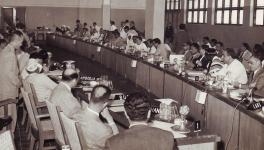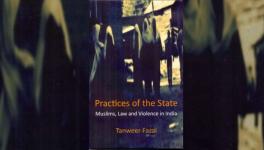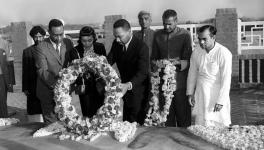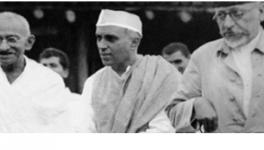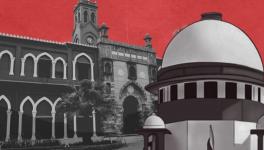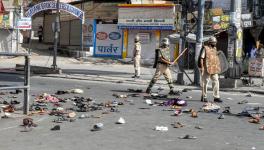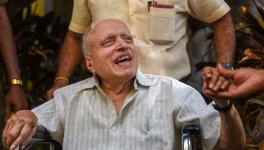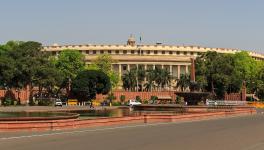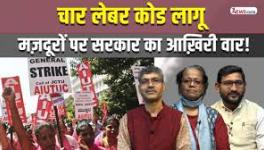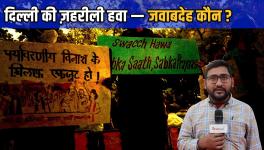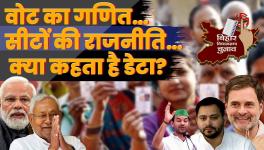REVIEW: Aditya Mukherjee’s Book on Nehru Tirelessly Ponders Over ‘Idea of India’
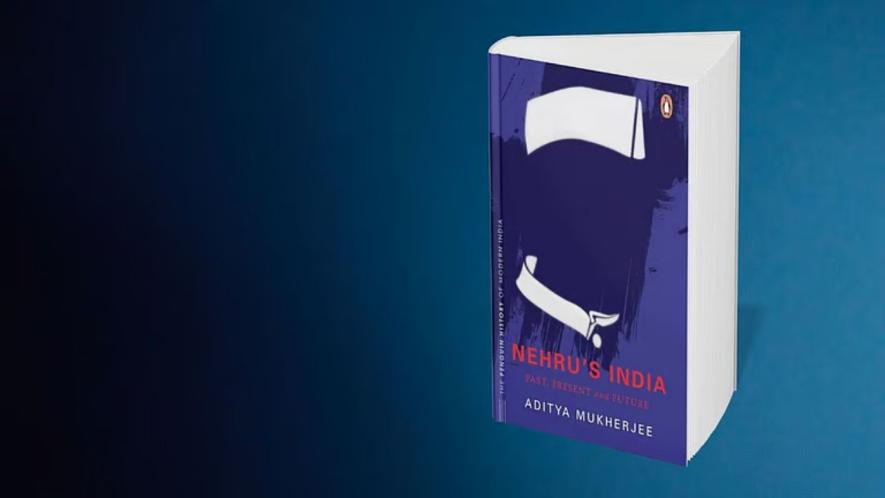
Review of ‘Nehru’s India: Past, Present & Future’, Penguin Random House India, Hardbound, Pages 210, MRP: INR 399
Jawaharal nehru’s persona has many facets to explore, read and write upon. In the preceding couple of quinquennials, some good titles written by both new and veteran authors bear testimony to this fact. For instance, Comrades against Imperialism (Michele L. Louro, 2019), Nehru's First Recruits (Kallol Bhattacharjee, 2024), Nehru: The Debates that defined India (Tripurdaman Singh and Adeel Hussain, 2022), Nehru and the Spirit of India (Manash Firaq Bhattacharjee, 2022), Nehru: Satya and Mithak (Piyush Babele, 2019), Nehru's India: A History in Seven Myths (Taylor C. Sherman, 2022), Jawaharlal Hazir Hon (Pankaj Chaturvedi, 2024), Planning Democracy (Nikhil Menon, 2022), Who is Bharat Mata? (Purushottam Agrawal, 2019), Sixteen Stormy Days (Tripurdaman Singh, 2020), Forging Capitalism in Nehru’s India (Nasir Tyabji, 2015) etc. represent a huge array of scholarship on topics ranging from foreign policy, foreign services, economic policy, nationalist struggle to post-colonial socio-political dynamics, fact-checking about Nehru and myth busting about Nehru’s India.
These works, though remarkable, may not appear very lucid and articulate to a common man due to inherent jargons or required domain expertise or bulky size. Aditya Mukherjee’s recent book Nehru’s India: Past, Present & Future (Penguin, 2024), on the contrary, deserves special praise for it is a lucid, comprehensible, coherent, short and logical account of Nehru’s India viewed from today’s vantage point. This work has been metamorphosed from Mukherjee’s Presidential address to Indian History Congress in 2023. He approaches the theme with a silver-tongue easily intelligible to a school student or a common man. The book is reportedly being translated into Hindi and Malayalam.
A major portion of the book is centered around the five core values which—according to Mukherjee—make the kernel of what is known as ‘the idea of India’. He proposes these core values in the third chapter, while the next five chapters provide an exegesis of each proposition. In this way, the book turns out to be a coherent and logical endeavour. Preceding two chapters—i.e. chapter 1 and 2—focus upon the ‘demonising of Nehru’ in the present scenario and Nehru’s approach to history respectively.
Aditya Mukherjee’s recent book Nehru’s India: Past, Present & Future (Penguin, 2024), on the contrary, deserves special praise for it is a lucid, comprehensible, coherent, short and logical account of Nehru’s India viewed from today’s vantage point.
The book starts with a Foreword written by Irfan Habib, eminent historian and professor emeritus at the Aligarh Muslim University (AMU), Aligarh. Habib has reminiscence of three instances when:
(1) Nehru visited his home at Aligarh in 1942,
(2) Habib met Nehru at the Central Secretariat through an appointment regarding denial of passport to him for research in England.
(3) Nehru visited Aligarh while Habib had become a teacher at AMU.
Habib finds him a man of larger commitment to reason and equity; and is hopeful that Jawaharlal Nehru and his work would always have an indelible impression ‘so long as truth and reason still find an audience’ in India.
Mukherjee is very categorical in his observation as he finds that Nehru was an undisputed champion of democracy and that he had a deep understanding of communalism. The title of the first chapter ‘Demonising of Nehru’ is self-evocative of why this book should be read widely. Under the current scenario when the idea of India faces perils at the hands of ‘communal fascists’—a term that Mukherjee borrows from Amartya Sen—Nehru bashing has become a norm.
In fact, this has now become much filthier with concerted efforts from politicians, IT cells, and a large section of what is known as ‘godi media’. Communal fascists, according to Mukherjee, are using a bi-pronged strategy to malign Nehru; first, they are running a huge propaganda machine to promote fake news and canards; second, they are adamant in erasing his memories from the country’s collective imagination. Nehru is demonised for his [alleged] secret Muslim ancestry, for his laundry at Paris, for his betrayal of Bhagat Singh and what not. He is being eliminated from text books as well as the names of state institutions. Mukherjee argues that Nehru is rebuked for every pothole in this country and that even the British did not resort to such filthy tactics against him.
Jawaharlal Nehru can be demonised only by distorting history, therefore, Mukherjee’s take on Nehru’s understanding of history in the next chapter is a corollary arrangement. In this section, Mukherjee has brilliantly deliberated on how history was a (a) scientific, (b) constructive and (c) global affair with Nehru. Nehru laid a framework for scientific perception of history and used the same in his Discovery of India (1946) that he wrote in prison.
Nehru’s approach was both scientific and constructive concomitantly, for he interpreted past conflicts in a constructive way vis-à-vis their colonial or communal interpretations. Mukherjee emphasises how the issue of ‘Hindu Trauma’ was discovered in the British House of Commons in 1843 and is still capitalised upon in the communal fascist echelon. Nehru’s logical exegesis finds ‘no man of faith’ in Mahmud Ghazni. Instead he was a warrior who used his army raised in India ‘against his co-religionists in Central Asia’. Nehru was determined to interpret history towards a modern and democratic India based on enlightenment values of rationality and acceptance of multiple claims to the truth, argues Mukherjee.
Constructive approach to history meant ‘history as a binding process’ that visualises India as an ancient palimpsest where multiple layers of thought express themselves in complete harmony. Nehru was very alive to the havoc unleashed by the colonial periodisation of Indian history by James Mill into (a) a Hindu Period, (b) a Muslim Period and (c) a British Period. Nehru called it an unscientific division.
Mukherjee remarkably argues that Nehru equally disliked the nationalist version which boasted of India’s past. Lastly, Jawaharlal Nehru, according to Mukherjee, was the greatest exponent of what is known today as ‘connected histories’. To Nehru, history could not be viewed in seclusion; it was a global affair as events in one part of the world affected the other. History was to be treated in a cumulative sense globally.
After this prelude of the contemporary and the past, Mukherjee, in the third chapter, identifies five core values of the ‘Idea of India’. These values are an outcome of decades of nationalist struggle. Not proposed by Jawaharlal Nehru but agreed upon by all hues of freedom fighters across the ideological spectrum, these values, according to Mukherjee, are: (1) Sovereignty, (2) Democracy, (3) Secularism, (4) Pro-people orientation and (5) Scientific Temper.
Mukherjee first deliberates upon secularism and the challenges it faces due to communalism. He argues that Nehru was the first in India to evolve a complex and scientific understanding of communalism. He had a clear understanding of democracy and communalism and on August 16, 1947, he outrightly called for ruthless suppression of communalism on the part of the government. With support of Patel, he banned the RSS and jailed its 25000 activists. Nehru travelled about 40,000 kilometers across India and addressed about 35 million people during the campaign of India's first general election just to establish that ‘vote for congress is vote for secularism’. Nehru was very categorical that:
-
Without secularism, there could be no democracy.
-
Communalism was a modern phenomenon; it was a colonial yield.
-
No compromise could be made with communalism. It needed a robust resistance.
Nehru’s thoughts on communalism were vindicated when Mahatma Gandhi was murdered by a communal fanatic. In the last section of this chapter, Mukherjee expresses his anguish for secular forces including the Congress Party as they failed to undertake a sustained ideological fight against communalism in India; rather they went on criticising and denouncing tall leaders of nationalist movement.
Nehru was a champion of democracy and by democracy he meant to ensure civil liberties at any cost. In the chapter ‘Building Democracy’, Mukherjee outlines that ‘democracy’ and ‘civil liberty’ were absolute values for Nehru. He never wanted a country where everyone would say ‘yes’ to one strong man. By writing a self-critical piece by a pseudonym of Chanakya, Nehru was warning himself against any compromise or dilution of democracy and civil liberties. Unlike today, Nehru never abhorred opposition in the parliament or in the press or elsewhere.
In the later section of the book, Mukherjee, with great finesse, addresses some questions pertaining to the Nehruvian economic policies and their outcomes. Nehru focused on industry and agriculture on equal footing, none was discriminated against the other, argues Mukherjee. Nehru’s quest for industrial transformation was directed towards democracy and consensus where surplus was not to be raised forcibly. Such transformation was unique and unprecedented in the world.
After independence, almost 90 percent of machine and machine tools were being imported. By Nehru-Mahalanobis strategy the import was reduced to 43 percent in 1960 that later became only 9 percent in 1974. Similarly, a robust but democratic land reforms initiative along with the Community Development Programme transformed the agriculture horizon. All these efforts on the part of the Nehru government had a pro-people orientation. It was socialism in action, argues Mukherjee; a socialism that was premised upon popular will and consensus. Nehru opposed the coercive approach of Stalin-Marxism.
The book ends with a short chapter of only four pages on ‘scientific temper’—the term that Mukherjee attributes to be coined by Nehru. Scientific inquiry or scientific temper was very dear to Jawaharlal Nehru. This chapter could have been more elaborated by Prof. Mukherjee as he posits that Nehru was a republican and a democrat, and was a man of action only due to his deeper interest in science. His abhorrence towards capitalism and love for socialism was all science-based. He analysed history, religion and culture on the touchstone of science.
To Nehru, history could not be viewed in seclusion; it was a global affair as events in one part of the world affected the other.
Mukherjee critically comments in good faith on Manash Firaq Bhattacharjee’s recent work Nehru and the Spirit of India (2022) but much was anticipated from him on observations made by Tripurdaman Singh in his Sixteen Stormy Days (2020) on questions of press freedom and first amendment to the Constitution. But, let me admit it wholeheartedly - addressing these questions would have again turned this book into an academic pursuit that otherwise in its current form is very intelligible to a common man or a college goer. The book needs to be translated into many languages and deserves a wider read.
Naved Ashrafi teaches Public Administration at the Maulana Azad National Urdu University, Hyderabad.
Courtesy: The Leaflet
Get the latest reports & analysis with people's perspective on Protests, movements & deep analytical videos, discussions of the current affairs in your Telegram app. Subscribe to NewsClick's Telegram channel & get Real-Time updates on stories, as they get published on our website.











